UNITED STATES
SECURITIES AND EXCHANGE COMMISSION
Washington, D.C. 20549
FORM N-CSR
CERTIFIED SHAREHOLDER REPORT OF REGISTERED
MANAGEMENT INVESTMENT COMPANIES
(Exact name of registrant as specified in charter)
(Name and address of agent for service)
Registrant’s telephone number, including area code: (410) 345-2000
Date of fiscal year end: October 31
Date of reporting period: October 31, 2021
 |
Global Stock Fund | October 31, 2021 |
| PRGSX | Investor Class |
| PAGSX | Advisor Class |
| TRGLX | I Class |
| T. ROWE PRICE GLOBAL STOCK FUND |
HIGHLIGHTS
| ■ | The Global Stock Fund returned 36.84% during the 12-month reporting period, underperforming its benchmark, the MSCI All Country World Index Net, but outperforming the Lipper peer group average. |
| ■ | Relative underperformance was mainly driven by our lack of exposure to the energy sector, as well as adverse stock selection in health care. On the positive side, holdings in the industrials and business services and communication services sectors aided relative results. At the regional level, stock choices in developed Europe hurt relative performance, although a favorable overweight position helped offset some of the negative results. On the positive side, a combination of an underweight and strong stock selection in emerging markets boosted relative returns. |
| ■ | In terms of positioning, our largest sector overweights at the end of the reporting period were communication services and consumer discretionary, while our largest underweight positions were in information technology and materials. At the regional level, we were overweight developed Europe and underweight North America. |
| ■ | As global economies begin to heal and emerge from the coronavirus pandemic, it is important to appreciate the long, winding road “back to the future”—a new normal defined by fundamental and behavioral differences. It remains critical to distinguish between the “chasm crossers,” those companies that will succeed and thrive, and the “imposters,” those companies that experienced temporary benefits that will likely not prove durable—an approach that we believe requires imagination and a carefully contrarian mindset. |

Log in to your account at troweprice.com for more information.
*Certain mutual fund accounts that are assessed an annual account service fee can also save money by switching to e-delivery.
CIO Market Commentary
Dear Shareholder
Global stock markets produced strong returns during your fund’s fiscal year, the 12-month period ended October 31, 2021. The rollout of coronavirus vaccines helped drive extraordinary gains in the first half of the reporting period, and while the equity rally slowed in recent months, some benchmarks continued to grind out new record highs as the period came to an end.
In the U.S., the S&P 500 Index was up 43% (including dividends) for the 12-month period, and most developed market benchmarks advanced more than 30%. Emerging markets produced solid results for the full year but faced increased volatility in the second half of the period. According to MSCI, value stocks narrowly outperformed their growth counterparts over the 12 months. At the sector level, energy stocks delivered very strong returns as oil prices reached multiyear highs, and banks also performed well, supported by higher longer-term interest rates and improved lending margins.
Fixed income markets faced headwinds as Treasury yields rose rapidly in the first quarter of 2021 from the historically low levels seen last year, although high yield bonds performed well. Meanwhile, the U.S. dollar was mixed against foreign currencies over the full year.
Strong corporate earnings growth supported stocks and corporate bonds throughout the period, but investors faced new worries as the period progressed. The spread of the delta variant of the coronavirus dashed hopes that vaccines would bring about a quick end to the pandemic, and economic growth, while still positive, began to slow. U.S. gross domestic product decelerated from a 6.7% annual pace in the second quarter to 2.0% in the third quarter (according to the initial estimate) amid weaker consumer spending. Some Purchasing Managers’ Indexes showed evidence of slowing economic activity globally.
Investors also worried about how developments in China would impact the global economy. The Chinese government announced more stringent business regulations during the period, particularly on the technology sector, and the precarious debt load of a large property developer added to market concerns.
Meanwhile, inflation surged as the release of pent-up demand and supply chain disruptions contributed to higher prices around the globe. Inflation measures in the U.S., UK, and eurozone all reached their highest levels in more than a decade and far exceeded central bank targets, although most policymakers argued that elevated inflation was a transitory phenomenon caused by the reopening of economies.
The fiscal and monetary stimulus that global governments and central banks enacted in response to the pandemic continued to be supportive for markets but appears to have peaked. Just after our reporting period ended, the Federal Reserve announced it would begin trimming its purchases of Treasury bonds and mortgage-backed securities in November and would likely wrap up its asset purchases by next summer. The Fed’s latest projections indicated that a rate hike isn’t likely until the second half of next year at the earliest, but other central banks have begun telegraphing that rate hikes could come soon.
How markets respond to the normalization of monetary policy is an open question. While fading stimulus might pose some challenges for investors, I believe it could contribute to a return of price sensitivity in global markets, which bodes well for selective investors focused on fundamentals.
While I do not expect robust overall equity returns in the near term given the market’s elevated valuations, I am mindful that investors have not yet enjoyed all the potential fruits of the recovery. Many companies have yet to see business return to pre-pandemic levels, and identifying which ones are either regaining their footing or disrupting markets through innovation will be key. I’m confident our portfolio managers and global research organization will serve our investors well in this environment.
Thank you for your continued confidence in T. Rowe Price.
Sincerely,

Robert Sharps
Group Chief Investment Officer
Management’s Discussion of Fund Performance
INVESTMENT OBJECTIVE
The fund seeks long-term growth of capital through investments primarily in the common stocks of established companies throughout the world, including the U.S.
FUND COMMENTARY
How did the fund perform in the past six months?
The Global Stock Fund returned 36.84% in the 12-month period ended October 31, 2021. The fund underperformed the MSCI All Country World Index Net benchmark, which returned 37.28%, but outperformed the Lipper Global Multi-Cap Growth Funds Average, which returned 36.27%. (Returns for the Advisor and I Class shares varied slightly, reflecting their different fee structures. Past performance cannot guarantee future results.)
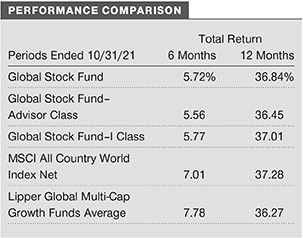
What factors influenced the fund’s performance?
From a sector perspective, the fund’s relative underperformance was mainly due to our lack of exposure to the energy sector. Stock selection in the health care sector also hurt relative returns. On the positive side, holdings in the industrials and business services sector contributed the most to relative results, and stock picks in communication services also helped. At the regional level, stock choices in developed Europe hurt relative performance the most, although a favorable overweight allocation within the region offset a portion of the negative results from stock selection. On the positive side, a combination of an underweight and strong stock selection in emerging markets boosted relative returns.
Our lack of exposure to the energy sector was the factor that hurt relative performance the most. Oil oversupply fears have receded in recent months as the reopening of the global economy has bolstered demand. However, we still have a subdued long-term outlook on the energy sector given the disruptive impact of U.S. shale production and the growing emphasis on clean energy and environmental, social, and governance consciousness. As a result, we have no exposure to the sector.
Within the health care sector, Exact Sciences was the largest relative detractor. Exact Sciences is a molecular diagnostics company focused on commercializing Cologuard, a noninvasive, stool-based screening assay for the early detection of colorectal cancer and precancerous lesions. Shares fell on disappointing earnings results as pandemic-related headwinds continued to hinder the screening business. We continue to have high conviction in the name due to what we see as a long runway for growth. (Please refer to the portfolio of investments for a complete list of holdings and the amount each represents in the portfolio.)
On the positive side, stock selection in industrials and business services helped relative performance, and our position in equipment rental company Ashtead helped the most. Ashtead outperformed amid strong earnings results, a cyclical market rotation, and improved fundamentals driven by accelerating market share gains. We are encouraged by the high quality of the business and are optimistic that Ashtead will continue to gain market share in its core segment.
Holdings in communication services also aided relative results. Southeast Asian mobile platform Sea rose on a series of strong earnings results and better-than- expected guidance, driven by impressive growth in e-commerce marketplace and gaming. The firm’s gaming expansion into the U.S., the second-largest market next to China, was also an encouraging development. We continue to believe that Sea’s platform is well positioned to gain share in Southeast Asia’s high-margin online gaming market, with additional growth supported by an underappreciated consumer-to-consumer e-commerce marketplace with improving monetization trends.
How is the fund positioned?
Over the period, we trimmed our exposure to the most fairly valued coronavirus beneficiaries while adding to positions that we believe will experience accelerating fundamentals as we enter and progress through 2022. In our view, the pandemic will continue to accelerate several existing and nascent trends that chiefly benefit growth companies—like those leveraged to e-commerce, digital media, and cloud computing—but we are also mindful of valuations and want to take advantage of opportunities in more cyclical segments of the market that should experience an inflection as the world continues to emerge from the pandemic.
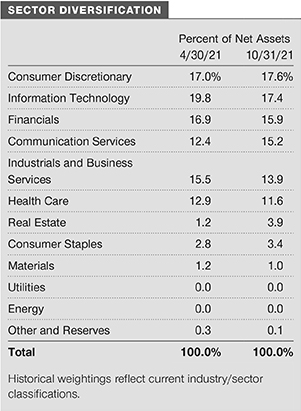
At the end of October, the fund’s largest overweight positions were in communication services and the consumer discretionary sector, two areas with a mix of cyclical and secular traits that have what we feel are solid tailwinds heading into a post-COVID world. Conversely, the fund’s largest underweight positions were in information technology and materials.
Over the 12-month period, our allocation to information technology decreased the most of any sector in both absolute and relative terms. We moved from a significant overweight at the beginning of the period to a meaningful underweight by the end of October. Within the sector, we reduced our exposure to the semiconductor industry, which faces increasingly challenging earnings comparisons over the next year due to strong performance during the height of the pandemic. In our view, the powerful long-run trends that we believe will drive value creation in the technology space should remain in play. However, this is a sector that has a large number of “COVID on” names that have performed exceptionally well but that we feel have more limited near-term upside. We eliminated our stakes in Qualcomm, Maxim Integrated Products, and Apple, the latter of which was due to reduced risk/reward trade-off due to our view that the near-term setup could be challenging as 5G product cycle tailwinds begin to fade. We also meaningfully trimmed our positions in Infineon Technologies, MasterCard, and Bill. Com Holdings.
Conversely, our largest increase in both absolute and relative weighting occurred in the communication services sector, where we moved from an underweight to a meaningful overweight. We believe that the lasting behavioral effects from the coronavirus pandemic could accelerate the long-term trend of streaming video services taking share from traditional television and exacerbate the ongoing shift toward digital advertising. We remain focused on highly innovative, secular growers within the entertainment and internet services spaces that we believe are on the right side of change and benefiting from accelerating popularity of digital media. Within the sector, our biggest new position was in T-Mobile US, which we think is well positioned for accelerating revenue and free cash flow growth following its recent acquisition of Sprint. In our view, T-Mobile has the potential to become the best wireless network in the U.S. as it realizes synergies from the Sprint merger, increases its exposure to suburban and rural areas as well as the enterprise wireless market segment, and further expands its 5G network leadership. We also started positions in Walt Disney, Tencent Holdings, and Netflix.
Regionally, our positioning is the result of fundamental, bottom-up stock selection. We increased our weighting to North America while reducing our exposure to Japan and Latin America. While we are underweight North America, it still makes up the majority of our geographic allocation at approximately 59% of assets. We also have been adding thoughtfully and selectively to China, which we believe is an area of opportunity amid the region’s recent market dislocation.
What is portfolio management’s outlook?
Equity markets were volatile during the period as concerns around the new delta variant of COVID-19 contended with optimism surrounding accelerated global vaccine distribution. As global economies begin to heal and emerge from the coronavirus pandemic, it is important to appreciate the long, winding road “back to the future”—a new normal defined by fundamental and behavioral differences. Within equity markets, much debate centers on the future path of interest rates, inflation, and economic growth. Asset prices may be high, but they are high for a reason: Interest rates remain low, government stimulus has been unprecedented, and there is no credit cycle to act as a disruptor. While we do see areas of the market that have become crowded in such a momentum- driven environment and are using prudence and our active approach to avoid significantly mispriced risk, ultimately, we expect economies and markets to normalize in 2022 as the pandemic wanes.
We are also witnessing “absurd” inflation in many areas of the economy, as well as general inflation in the labor market—distortions we believe are driven by the pandemic. However, we believe we have now reached peak inflation and expect some of the recent extreme inflation to wane as the economy emerges from the pandemic. We also acknowledge that economic growth on a year-on-year basis is not likely to fully normalize until the latter part of next year.
While the U.S. Federal Reserve contemplates its next moves, which likely means a less accommodative policy going forward, we expect interest rates to remain historically low. In our view, an environment with moderate inflation and moderately higher interest rates could be a positive catalyst for equities, creating a “goldilocks” scenario for active equity investors. We are comfortable with our positioning and continue to search for solid growth assets that are out of favor currently but where we see potentially higher growth in 2022 and beyond—like some travel-related names and select financials. We also believe it is worth exploring China’s regulatory changes and the opportunities that it may create—albeit with prudence.
As we move through this extraordinary period, we continue to focus our efforts on the hard and difficult choices required during these complex times. Our aim is to own stocks of companies for which we have insight about improving economic returns while avoiding stocks that imply unnecessary risks. This is our role as fundamental, bottom-up stock pickers. Ultimately, we favor companies with idiosyncratic drivers that we believe are on the right side of change. It remains critical as we move “back to the future” to distinguish between the “chasm crossers,” those companies that will succeed and thrive, and the “imposters,” those companies that experienced temporary benefits that will likely not prove durable. This approach often requires imagination and a carefully contrarian mindset, but experience has shown that making difficult decisions by adhering to our investment framework with the support of our global research platform ultimately can add value for our clients.
The views expressed reflect the opinions of T. Rowe Price as of the date of this report and are subject to change based on changes in market, economic, or other conditions. These views are not intended to be a forecast of future events and are no guarantee of future results.
RISKS OF INTERNATIONAL INVESTING
Funds that invest overseas generally carry more risk than funds that invest strictly in U.S. assets. Funds investing in a single country or in a limited geographic region tend to be riskier than more diversified funds. Risks can result from varying stages of economic and political development; differing regulatory environments, trading days, and accounting standards; and higher transaction costs of non-U.S. markets. Non-U.S. investments are also subject to currency risk, or a decline in the value of a foreign currency versus the U.S. dollar, which reduces the dollar value of securities denominated in that currency.
BENCHMARK INFORMATION
Note: Lipper, a Thomson Reuters Company, is the source for all Lipper content reflected in these materials. Copyright 2021 © Refinitiv. All rights reserved. Any copying, republication or redistribution of Lipper content is expressly prohibited without the prior written consent of Lipper. Lipper shall not be liable for any errors or delays in the content, or for any actions taken in reliance thereon.
Note: MSCI makes no express or implied warranties or representations and shall have no liability whatsoever with respect to any MSCI data contained herein. The MSCI data may not be further redistributed or used as a basis for other indices or any securities or financial products. This report is not approved, reviewed, or produced by MSCI.
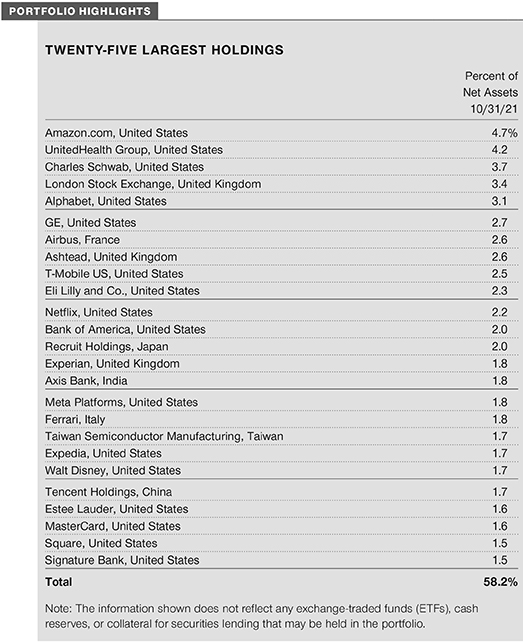
GROWTH OF $10,000
This chart shows the value of a hypothetical $10,000 investment in the fund over the past 10 fiscal year periods or since inception (for funds lacking 10-year records). The result is compared with benchmarks, which include a broad-based market index and may also include a peer group average or index. Market indexes do not include expenses, which are deducted from fund returns as well as mutual fund averages and indexes.
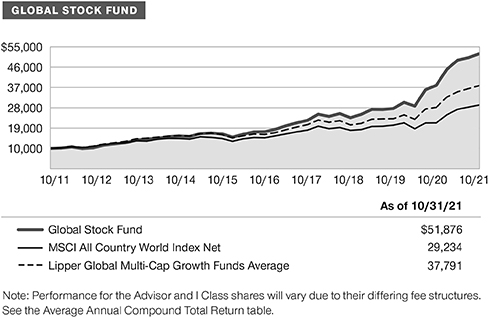
AVERAGE ANNUAL COMPOUND TOTAL RETURN
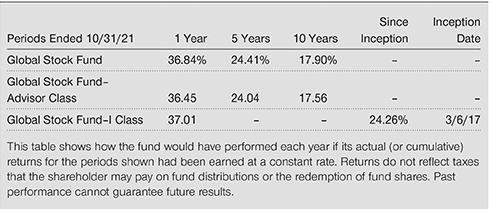
EXPENSE RATIO

FUND EXPENSE EXAMPLE
As a mutual fund shareholder, you may incur two types of costs: (1) transaction costs, such as redemption fees or sales loads, and (2) ongoing costs, including management fees, distribution and service (12b-1) fees, and other fund expenses. The following example is intended to help you understand your ongoing costs (in dollars) of investing in the fund and to compare these costs with the ongoing costs of investing in other mutual funds. The example is based on an investment of $1,000 invested at the beginning of the most recent six-month period and held for the entire period.
Please note that the fund has three share classes: The original share class (Investor Class) charges no distribution and service (12b-1) fee, the Advisor Class shares are offered only through unaffiliated brokers and other financial intermediaries and charge a 0.25% 12b-1 fee, and I Class shares are available to institutionally oriented clients and impose no 12b-1 or administrative fee payment. Each share class is presented separately in the table.
Actual Expenses
The first line of the following table (Actual) provides information about actual account values and expenses based on the fund’s actual returns. You may use the information on this line, together with your account balance, to estimate the expenses that you paid over the period. Simply divide your account value by $1,000 (for example, an $8,600 account value divided by $1,000 = 8.6), then multiply the result by the number on the first line under the heading “Expenses Paid During Period” to estimate the expenses you paid on your account during this period.
Hypothetical Example for Comparison Purposes
The information on the second line of the table (Hypothetical) is based on hypothetical account values and expenses derived from the fund’s actual expense ratio and an assumed 5% per year rate of return before expenses (not the fund’s actual return). You may compare the ongoing costs of investing in the fund with other funds by contrasting this 5% hypothetical example and the 5% hypothetical examples that appear in the shareholder reports of the other funds. The hypothetical account values and expenses may not be used to estimate the actual ending account balance or expenses you paid for the period.
Note: T. Rowe Price charges an annual account service fee of $20, generally for accounts with less than $10,000. The fee is waived for any investor whose T. Rowe Price mutual fund accounts total $50,000 or more; accounts electing to receive electronic delivery of account statements, transaction confirmations, prospectuses, and shareholder reports; or accounts of an investor who is a T. Rowe Price Personal Services or Enhanced Personal Services client (enrollment in these programs generally requires T. Rowe Price assets of at least $250,000). This fee is not included in the accompanying table. If you are subject to the fee, keep it in mind when you are estimating the ongoing expenses of investing in the fund and when comparing the expenses of this fund with other funds.
You should also be aware that the expenses shown in the table highlight only your ongoing costs and do not reflect any transaction costs, such as redemption fees or sales loads. Therefore, the second line of the table is useful in comparing ongoing costs only and will not help you determine the relative total costs of owning different funds. To the extent a fund charges transaction costs, however, the total cost of owning that fund is higher.
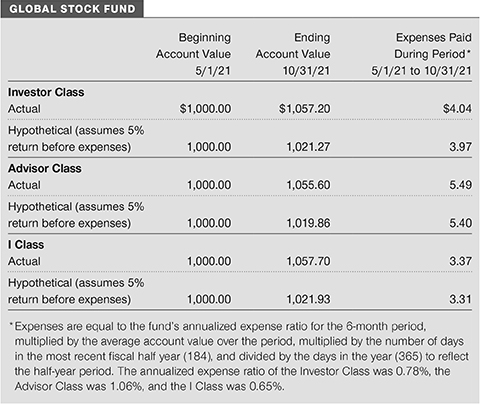
QUARTER-END RETURNS
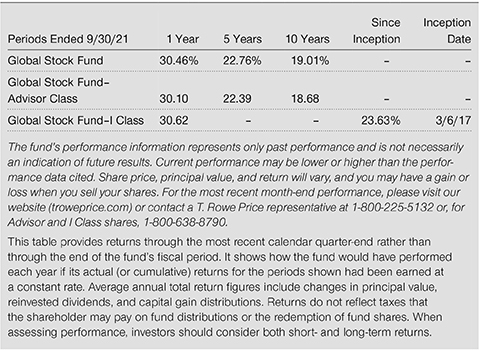
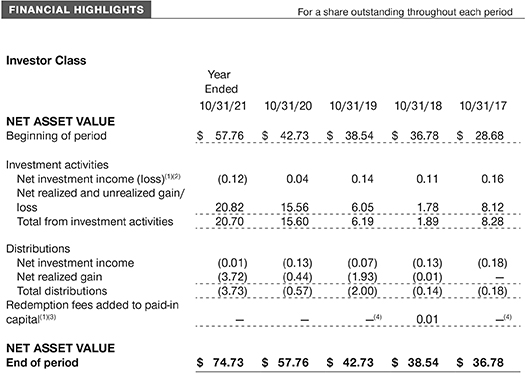
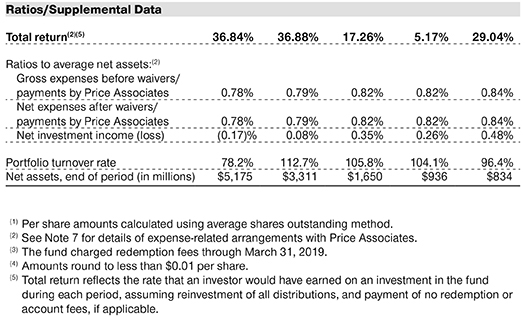
The accompanying notes are an integral part of these financial statements.
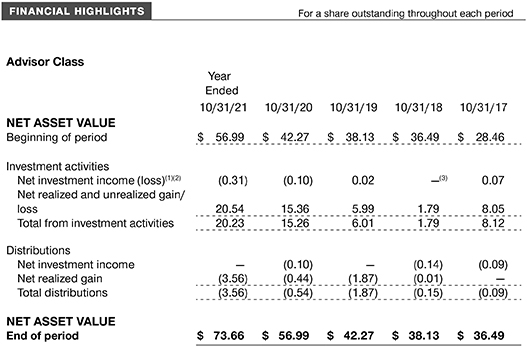
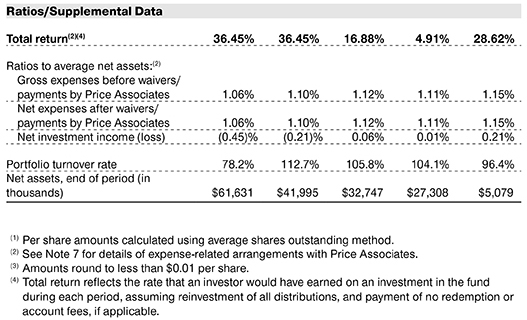
The accompanying notes are an integral part of these financial statements.
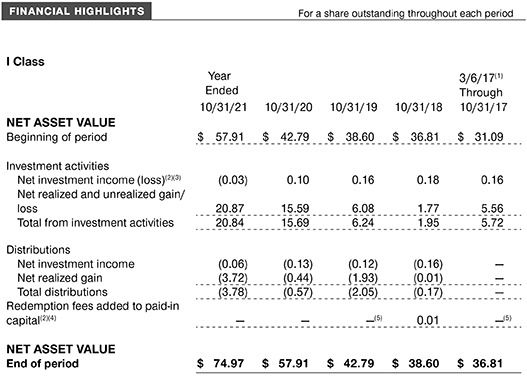
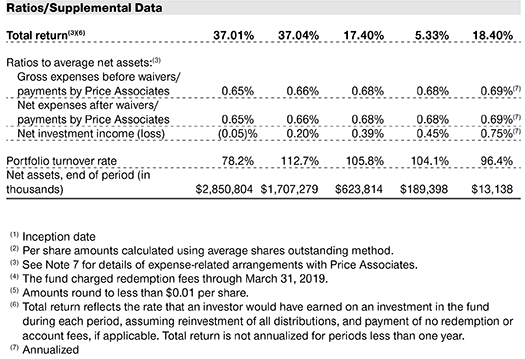
The accompanying notes are an integral part of these financial statements.
October 31, 2021
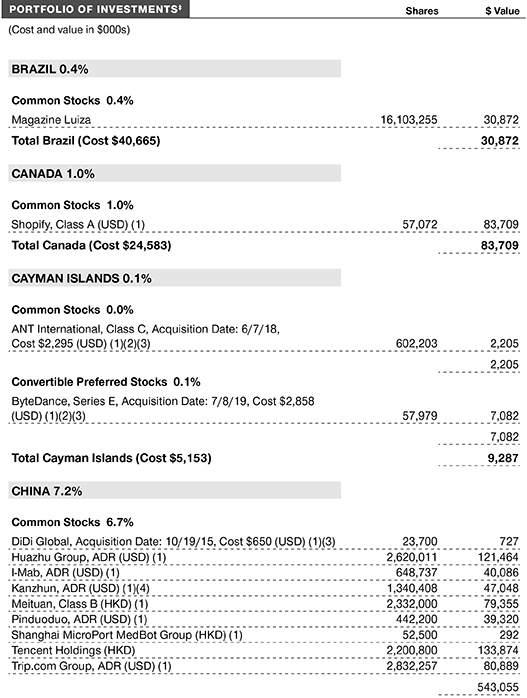
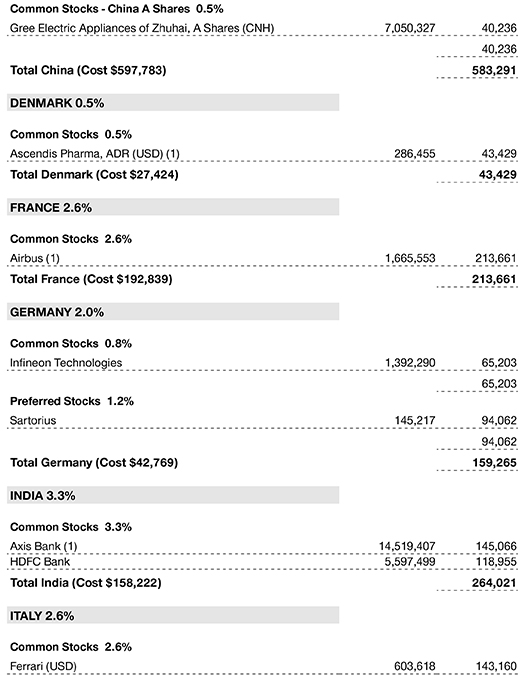
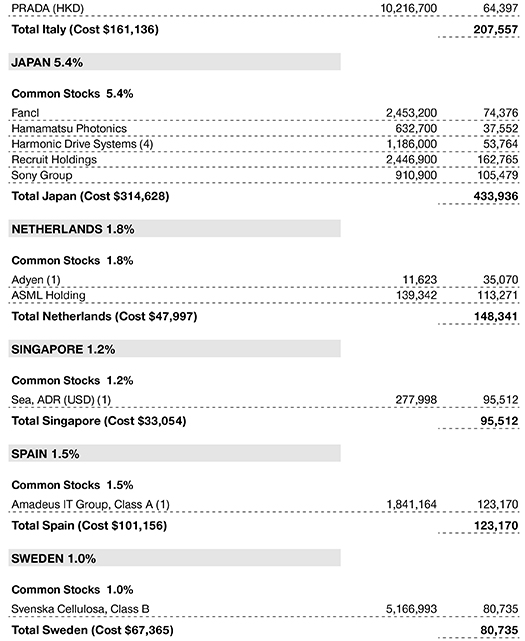
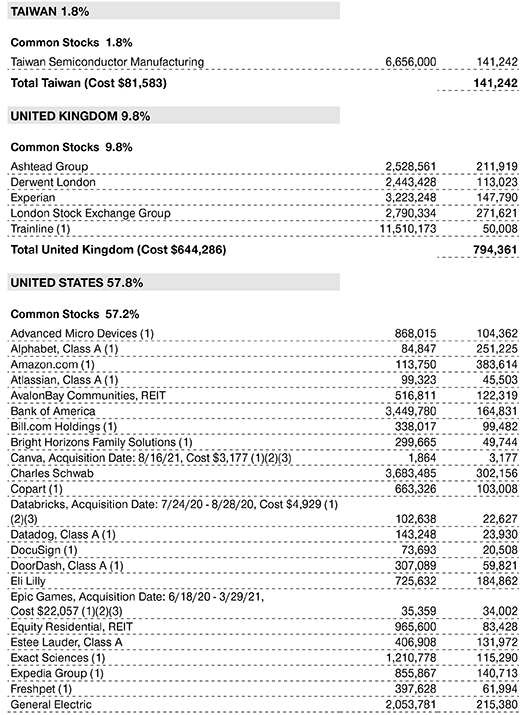
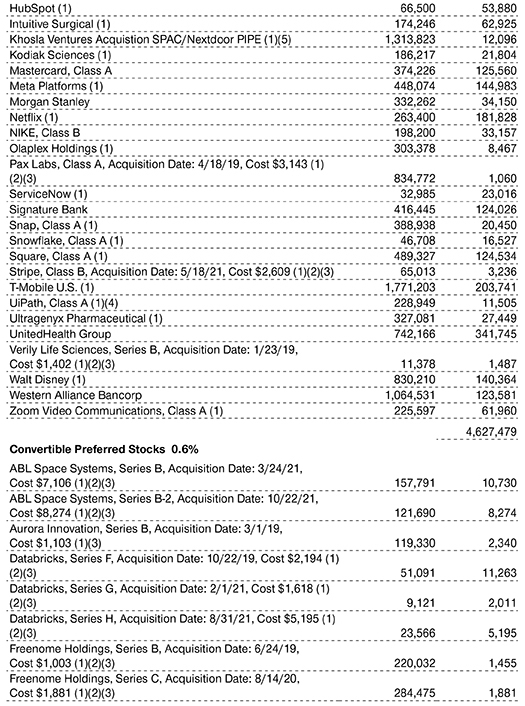
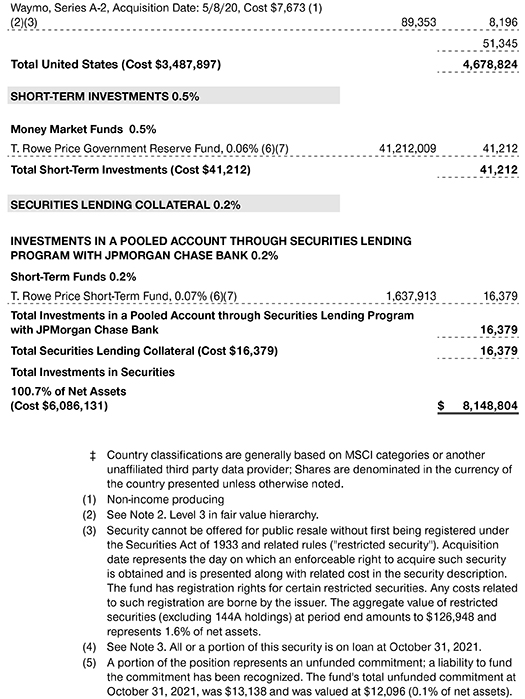

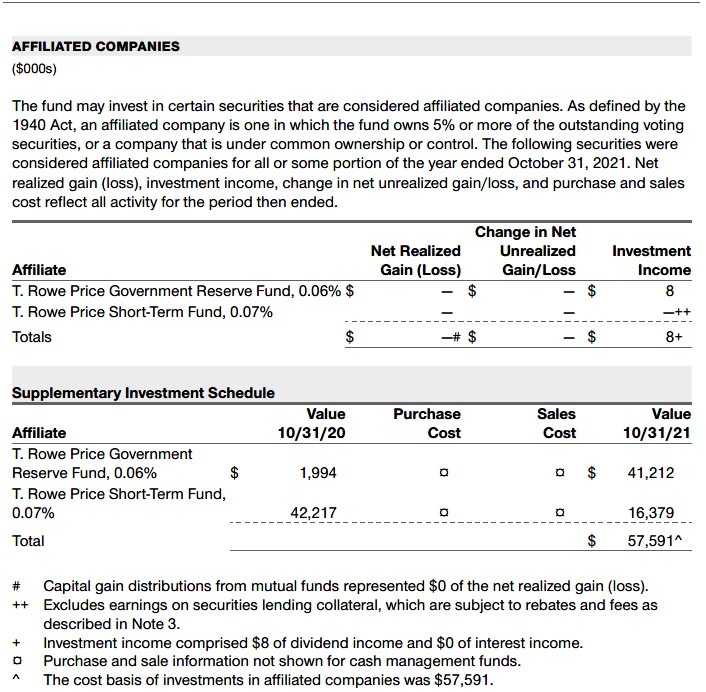
The accompanying notes are an integral part of these financial statements.
October 31, 2021
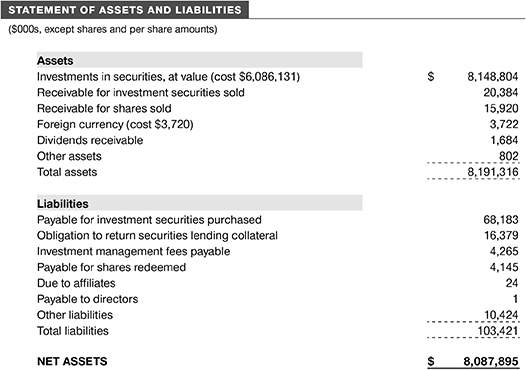
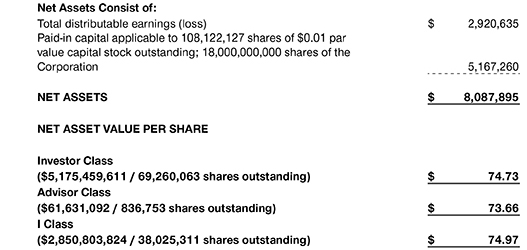
The accompanying notes are an integral part of these financial statements.
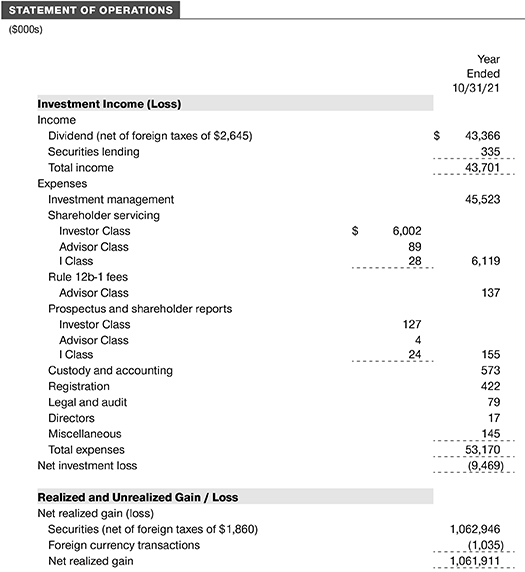

The accompanying notes are an integral part of these financial statements.
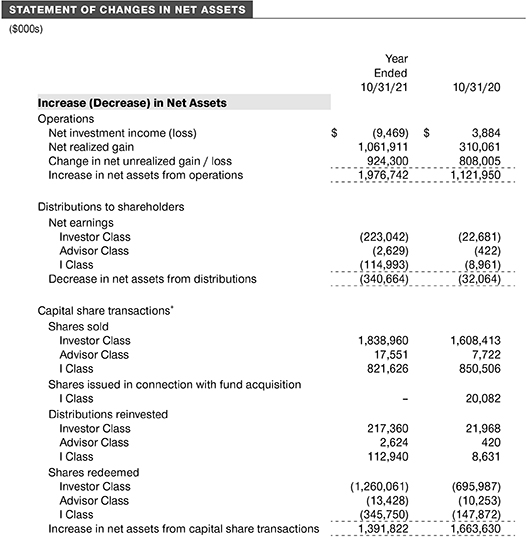
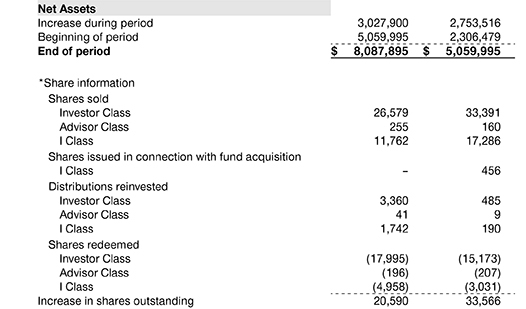
The accompanying notes are an integral part of these financial statements.
| NOTES TO FINANCIAL STATEMENTS |
T. Rowe Price International Funds, Inc. (the corporation) is registered under the Investment Company Act of 1940 (the 1940 Act). The Global Stock Fund (the fund) is a diversified, open-end management investment company established by the corporation. The fund seeks long-term growth of capital through investments primarily in the common stocks of established companies throughout the world, including the U.S. The fund has three classes of shares: the Global Stock Fund (Investor Class), the Global Stock Fund–Advisor Class (Advisor Class), and the Global Stock Fund–I Class (I Class). Advisor Class shares are sold only through various brokers and other financial intermediaries. I Class shares require a $1 million initial investment minimum, although the minimum generally is waived for retirement plans, financial intermediaries, and certain other accounts. The Advisor Class operates under a Board-approved Rule 12b-1 plan pursuant to which the class compensates financial intermediaries for distribution, shareholder servicing, and/or certain administrative services; the Investor and I Classes do not pay Rule 12b-1 fees. Each class has exclusive voting rights on matters related solely to that class; separate voting rights on matters that relate to all classes; and, in all other respects, the same rights and obligations as the other classes.
NOTE 1 - SIGNIFICANT ACCOUNTING POLICIES
Basis of Preparation The fund is an investment company and follows accounting and reporting guidance in the Financial Accounting Standards Board (FASB) Accounting Standards Codification Topic 946 (ASC 946). The accompanying financial statements were prepared in accordance with accounting principles generally accepted in the United States of America (GAAP), including, but not limited to, ASC 946. GAAP requires the use of estimates made by management. Management believes that estimates and valuations are appropriate; however, actual results may differ from those estimates, and the valuations reflected in the accompanying financial statements may differ from the value ultimately realized upon sale or maturity.
Investment Transactions, Investment Income, and Distributions Investment transactions are accounted for on the trade date basis. Income and expenses are recorded on the accrual basis. Realized gains and losses are reported on the identified cost basis. Income tax-related interest and penalties, if incurred, are recorded as income tax expense. Dividends received from mutual fund investments are reflected as dividend income; capital gain distributions are reflected as realized gain/loss. Dividend income and capital gain distributions are recorded on the ex-dividend date. Distributions from REITs are initially recorded as dividend income and, to the extent such represent a return of capital or capital gain for tax purposes, are reclassified when such information becomes available. Non-cash dividends, if any, are recorded at the fair market value of the asset received. Distributions to shareholders are recorded on the ex-dividend date. Income distributions, if any, are declared and paid by each class annually. A capital gain distribution may also be declared and paid by the fund annually.
Currency Translation Assets, including investments, and liabilities denominated in foreign currencies are translated into U.S. dollar values each day at the prevailing exchange rate, using the mean of the bid and asked prices of such currencies against U.S. dollars as provided by an outside pricing service. Purchases and sales of securities, income, and expenses are translated into U.S. dollars at the prevailing exchange rate on the respective date of such transaction. The effect of changes in foreign currency exchange rates on realized and unrealized security gains and losses is not bifurcated from the portion attributable to changes in market prices.
Class Accounting Shareholder servicing, prospectus, and shareholder report expenses incurred by each class are charged directly to the class to which they relate. Expenses common to all classes, investment income, and realized and unrealized gains and losses are allocated to the classes based upon the relative daily net assets of each class. The Advisor Class pays Rule 12b-1 fees, in an amount not exceeding 0.25% of the class’s average daily net assets.
Capital Transactions Each investor’s interest in the net assets of the fund is represented by fund shares. The fund’s net asset value (NAV) per share is computed at the close of the New York Stock Exchange (NYSE), normally 4 p.m. ET, each day the NYSE is open for business. However, the NAV per share may be calculated at a time other than the normal close of the NYSE if trading on the NYSE is restricted, if the NYSE closes earlier, or as may be permitted by the SEC. Purchases and redemptions of fund shares are transacted at the next-computed NAV per share, after receipt of the transaction order by T. Rowe Price Associates, Inc., or its agents.
Indemnification In the normal course of business, the fund may provide indemnification in connection with its officers and directors, service providers, and/or private company investments. The fund’s maximum exposure under these arrangements is unknown; however, the risk of material loss is currently considered to be remote.
NOTE 2 - VALUATION
Fair Value The fund’s financial instruments are valued at the close of the NYSE and are reported at fair value, which GAAP defines as the price that would be received to sell an asset or paid to transfer a liability in an orderly transaction between market participants at the measurement date. The T. Rowe Price Valuation Committee (the Valuation Committee) is an internal committee that has been delegated certain responsibilities by the fund’s Board of Directors (the Board) to ensure that financial instruments are appropriately priced at fair value in accordance with GAAP and the 1940 Act. Subject to oversight by the Board, the Valuation Committee develops and oversees pricing-related policies and procedures and approves all fair value determinations. Specifically, the Valuation Committee establishes policies and procedures used in valuing financial instruments, including those which cannot be valued in accordance with normal procedures or using pricing vendors; determines pricing techniques, sources, and persons eligible to effect fair value pricing actions; evaluates the services and performance of the pricing vendors; oversees the pricing process to ensure policies and procedures are being followed; and provides guidance on internal controls and valuation-related matters. The Valuation Committee provides periodic reporting to the Board on valuation matters.
Various valuation techniques and inputs are used to determine the fair value of financial instruments. GAAP establishes the following fair value hierarchy that categorizes the inputs used to measure fair value:
Level 1 – quoted prices (unadjusted) in active markets for identical financial instruments that the fund can access at the reporting date
Level 2 – inputs other than Level 1 quoted prices that are observable, either directly or indirectly (including, but not limited to, quoted prices for similar financial instruments in active markets, quoted prices for identical or similar financial instruments in inactive markets, interest rates and yield curves, implied volatilities, and credit spreads)
Level 3 – unobservable inputs (including the fund’s own assumptions in determining fair value)
Observable inputs are developed using market data, such as publicly available information about actual events or transactions, and reflect the assumptions that market participants would use to price the financial instrument. Unobservable inputs are those for which market data are not available and are developed using the best information available about the assumptions that market participants would use to price the financial instrument. GAAP requires valuation techniques to maximize the use of relevant observable inputs and minimize the use of unobservable inputs. When multiple inputs are used to derive fair value, the financial instrument is assigned to the level within the fair value hierarchy based on the lowest-level input that is significant to the fair value of the financial instrument. Input levels are not necessarily an indication of the risk or liquidity associated with financial instruments at that level but rather the degree of judgment used in determining those values.
Valuation Techniques Equity securities, including exchange-traded funds, listed or regularly traded on a securities exchange or in the over-the-counter (OTC) market are valued at the last quoted sale price or, for certain markets, the official closing price at the time the valuations are made. OTC Bulletin Board securities are valued at the mean of the closing bid and asked prices. A security that is listed or traded on more than one exchange is valued at the quotation on the exchange determined to be the primary market for such security. Listed securities not traded on a particular day are valued at the mean of the closing bid and asked prices for domestic securities and the last quoted sale or closing price for international securities.
The last quoted prices of non-U.S. equity securities may be adjusted to reflect the fair value of such securities at the close of the NYSE, if the fund determines that developments between the close of a foreign market and the close of the NYSE will affect the value of some or all of its portfolio securities. Each business day, the fund uses information from outside pricing services to evaluate and, if appropriate, decide whether it is necessary to adjust quoted prices to reflect fair value by reviewing a variety of factors, including developments in foreign markets, the performance of U.S. securities markets, and the performance of instruments trading in U.S. markets that represent foreign securities and baskets of foreign securities. The fund uses outside pricing services to provide it with quoted prices and information to evaluate or adjust those prices. The fund cannot predict how often it will use quoted prices and how often it will determine it necessary to adjust those prices to reflect fair value.
Investments in mutual funds are valued at the mutual fund’s closing NAV per share on the day of valuation. Assets and liabilities other than financial instruments, including short-term receivables and payables, are carried at cost, or estimated realizable value, if less, which approximates fair value.
Investments for which market quotations or market-based valuations are not readily available or deemed unreliable are valued at fair value as determined in good faith by the Valuation Committee, in accordance with fair valuation policies and procedures. The objective of any fair value pricing determination is to arrive at a price that could reasonably be expected from a current sale. Financial instruments fair valued by the Valuation Committee are primarily private placements, restricted securities, warrants, rights, and other securities that are not publicly traded. Factors used in determining fair value vary by type of investment and may include market or investment specific considerations. The Valuation Committee typically will afford greatest weight to actual prices in arm’s length transactions, to the extent they represent orderly transactions between market participants, transaction information can be reliably obtained, and prices are deemed representative of fair value. However, the Valuation Committee may also consider other valuation methods such as market-based valuation multiples; a discount or premium from market value of a similar, freely traded security of the same issuer; discounted cash flows; yield to maturity; or some combination. Fair value determinations are reviewed on a regular basis and updated as information becomes available, including actual purchase and sale transactions of the investment. Because any fair value determination involves a significant amount of judgment, there is a degree of subjectivity inherent in such pricing decisions, and fair value prices determined by the Valuation Committee could differ from those of other market participants.
Valuation Inputs The following table summarizes the fund’s financial instruments, based on the inputs used to determine their fair values on October 31, 2021 (for further detail by category, please refer to the accompanying Portfolio of Investments):
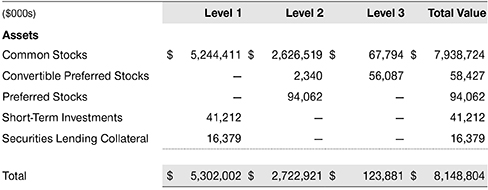
Following is a reconciliation of the fund’s Level 3 holdings for the year ended October 31, 2021. Gain (loss) reflects both realized and change in unrealized gain/loss on Level 3 holdings during the period, if any, and is included on the accompanying Statement of Operations. The change in unrealized gain/loss on Level 3 instruments held at October 31, 2021, totaled $43,642,000 for the year ended October 31, 2021. During the year, transfers into Level 3 resulted from a lack of observable market data for the security and transfers out of Level 3 were because observable market data became available for the security.
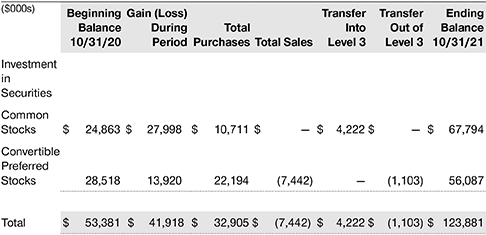
NOTE 3 - OTHER INVESTMENT TRANSACTIONS
Consistent with its investment objective, the fund engages in the following practices to manage exposure to certain risks and/or to enhance performance. The investment objective, policies, program, and risk factors of the fund are described more fully in the fund’s prospectus and Statement of Additional Information.
Emerging and Frontier Markets The fund invests, either directly or through investments in other T. Rowe Price funds, in securities of companies located in, issued by governments of, or denominated in or linked to the currencies of emerging and frontier market countries. Emerging markets, and to a greater extent frontier markets, generally have economic structures that are less diverse and mature, and political systems that are less stable, than developed countries. These markets may be subject to greater political, economic, and social uncertainty and differing regulatory environments that may potentially impact the fund’s ability to buy or sell certain securities or repatriate proceeds to U.S. dollars. Such securities are often subject to greater price volatility, less liquidity, and higher rates of inflation than U.S. securities. Investing in frontier markets is significantly riskier than investing in other countries, including emerging markets.
Private Investments Issued by Special Purpose Acquisition Companies Special purpose acquisition companies (SPACs) are shell companies that have no operations but are formed to raise capital with the intention of merging with or acquiring a company with the proceeds of the SPAC’s initial public offering (IPO). The fund may enter into a contingent commitment with a SPAC to purchase private investments in public equity (PIPE) if and when the SPAC completes its merger or acquisition. The fund maintains liquid assets sufficient to settle its commitment to purchase the PIPE. However, if the commitment expires, then no shares are purchased. Purchased PIPE shares will be restricted from trading until the registration statement for the shares is declared effective. Upon registration, the shares can be freely sold; however, in certain circumstances, the issuer may have the right to temporarily suspend trading of the shares in the first year after the merger or acquisition. The securities issued by a SPAC may be considered illiquid, more difficult to value, and/or be subject to restrictions on resale.
Restricted Securities The fund invests in securities that are subject to legal or contractual restrictions on resale. Prompt sale of such securities at an acceptable price may be difficult and may involve substantial delays and additional costs.
Securities Lending The fund may lend its securities to approved borrowers to earn additional income. Its securities lending activities are administered by a lending agent in accordance with a securities lending agreement. Security loans generally do not have stated maturity dates, and the fund may recall a security at any time. The fund receives collateral in the form of cash or U.S. government securities. Collateral is maintained over the life of the loan in an amount not less than the value of loaned securities; any additional collateral required due to changes in security values is delivered to the fund the next business day. Cash collateral is invested in accordance with investment guidelines approved by fund management. Additionally, the lending agent indemnifies the fund against losses resulting from borrower default. Although risk is mitigated by the collateral and indemnification, the fund could experience a delay in recovering its securities and a possible loss of income or value if the borrower fails to return the securities, collateral investments decline in value, and the lending agent fails to perform. Securities lending revenue consists of earnings on invested collateral and borrowing fees, net of any rebates to the borrower, compensation to the lending agent, and other administrative costs. In accordance with GAAP, investments made with cash collateral are reflected in the accompanying financial statements, but collateral received in the form of securities is not. At October 31, 2021, the value of loaned securities was $15,647,000; the value of cash collateral and related investments was $16,379,000.
Other Purchases and sales of portfolio securities other than short-term securities aggregated $6,578,075,000 and $5,553,719,000, respectively, for the year ended October 31, 2021.
NOTE 4 - FEDERAL INCOME TAXES
Generally, no provision for federal income taxes is required since the fund intends to continue to qualify as a regulated investment company under Subchapter M of the Internal Revenue Code and distribute to shareholders all of its taxable income and gains. Distributions determined in accordance with federal income tax regulations may differ in amount or character from net investment income and realized gains for financial reporting purposes.
The fund files U.S. federal, state, and local tax returns as required. The fund’s tax returns are subject to examination by the relevant tax authorities until expiration of the applicable statute of limitations, which is generally three years after the filing of the tax return but which can be extended to six years in certain circumstances. Tax returns for open years have incorporated no uncertain tax positions that require a provision for income taxes.
Financial reporting records are adjusted for permanent book/tax differences to reflect tax character but are not adjusted for temporary differences. The permanent book/tax adjustments have no impact on results of operations or net assets and relate primarily to redemptions in kind, a tax practice that treats a portion of the proceeds from each redemption of capital shares as a distribution of taxable net investment income or realized capital gain, the character of net currency losses, the character of foreign capital gains taxes and the offset of the current net operating loss against realized gains. For the year ended October 31, 2021, the following reclassification was recorded:

Distributions during the years ended October 31, 2021 and October 31, 2020, were characterized for tax purposes as follows:

At October 31, 2021, the tax-basis cost of investments and components of net assets were as follows:
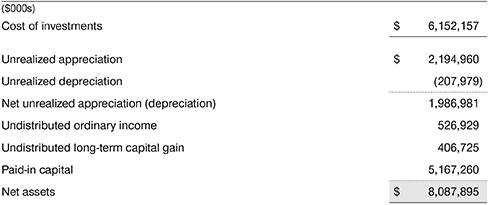
The difference between book-basis and tax-basis net unrealized appreciation (depreciation) is attributable to the deferral of losses from wash sales for tax purposes.
NOTE 5 - FOREIGN TAXES
The fund is subject to foreign income taxes imposed by certain countries in which it invests. Additionally, capital gains realized upon disposition of securities issued in or by certain foreign countries are subject to capital gains tax imposed by those countries. All taxes are computed in accordance with the applicable foreign tax law, and, to the extent permitted, capital losses are used to offset capital gains. Taxes attributable to income are accrued by the fund as a reduction of income. Current and deferred tax expense attributable to capital gains is reflected as a component of realized or change in unrealized gain/loss on securities in the accompanying financial statements. To the extent that the fund has country specific capital loss carryforwards, such carryforwards are applied against net unrealized gains when determining the deferred tax liability. Any deferred tax liability incurred by the fund is included in either Other liabilities or Deferred tax liability on the accompanying Statement of Assets and Liabilities.
NOTE 6 - ACQUISITION
On November 25, 2019, the fund acquired substantially all of the assets of the Institutional Global Focused Growth Equity Fund (the acquired fund), pursuant to the Agreement and Plan of Reorganization dated July 31, 2019. The acquired fund was available only to institutional investors and required an initial investment of $1,000,000; the same as the fund’s I Class investment minimum. The acquired fund shared a nearly identical investment program as the fund and the fund's I Class offered a lower net expense ratio than that of the acquired fund. Accordingly, it no longer made sense to offer both funds. The Boards of the acquired fund and the fund approved the reorganization and, the Board of the acquired fund approved its liquidation and dissolution. The acquisition was accomplished by a tax-free exchange of 456,000 shares of the fund with a value of $20,082,000 for all 1,830,000 shares of the acquired fund then outstanding, with the same value. The exchange was based on values at the close of the NYSE on the immediately preceding business day, November 22, 2019. The net assets of the acquired fund at that date included $2,562,000 of unrealized appreciation. Assets of the acquired fund, including securities of $18,799,000, cash of $1,259,000, and receivables and other assets of $24,000, were combined with those of the fund, resulting in aggregate net assets of $2,430,362,000 immediately after the acquisition.
Pro forma results of operations of the combined entity for the entire year ended October 31, 2020, as though the acquisition had occurred as of the beginning of the year (rather than on the actual acquisition date), are as follows:

NOTE 7 - RELATED PARTY TRANSACTIONS
The fund is managed by T. Rowe Price Associates, Inc. (Price Associates), a wholly owned subsidiary of T. Rowe Price Group, Inc. (Price Group). Price Associates has entered into a sub-advisory agreement(s) with one or more of its wholly owned subsidiaries, to provide investment advisory services to the fund. The investment management agreement between the fund and Price Associates provides for an annual investment management fee, which is computed daily and paid monthly. The fee consists of an individual fund fee, equal to 0.35% of the fund’s average daily net assets, and a group fee. The group fee rate is calculated based on the combined net assets of certain mutual funds sponsored by Price Associates (the group) applied to a graduated fee schedule, with rates ranging from 0.48% for the first $1 billion of assets to 0.260% for assets in excess of $845 billion. The fund’s group fee is determined by applying the group fee rate to the fund’s average daily net assets. The fee is computed daily and paid monthly. At October 31, 2021, the effective annual group fee rate was 0.28%. Effective November 1, 2019, Price Associates agreed to permanently waive a portion of the fund’s annual investment management fee in order to limit the fund’s management fees to 0.65% of the fund’s average daily net assets. This agreement can only be modified or terminated with approval by the fund’s shareholders. The fund has no obligation to repay fees waived under this arrangement. No management fees were waived under this arrangement for the year ended October 31, 2021.
The I Class is subject to an operating expense limitation (I Class Limit) pursuant to which Price Associates is contractually required to pay all operating expenses of the I Class, excluding management fees; interest; expenses related to borrowings, taxes, and brokerage; and other non-recurring expenses permitted by the investment management agreement, to the extent such operating expenses, on an annualized basis, exceed the I Class Limit. This agreement will continue through the expense limitation date indicated in the table below, and may be renewed, revised, or revoked only with approval of the fund’s Board. The I Class is required to repay Price Associates for expenses previously paid to the extent the class’s net assets grow or expenses decline sufficiently to allow repayment without causing the class’s operating expenses (after the repayment is taken into account) to exceed the lesser of: (1) the I Class Limit in place at the time such amounts were paid; or (2) the current I Class Limit. However, no repayment will be made more than three years after the date of a payment or waiver.
Effective November 1, 2019, the I Class was also subject to a contractual expense limitation through February 28, 2021. During the limitation period, Price Associates was required to waive its management fee or pay any expenses (excluding interest; expenses related to borrowings, taxes, and brokerage; and other non-recurring expenses permitted by the investment management agreement) that would otherwise cause the class’s ratio of annualized total expenses to average net assets (net expense ratio) to exceed 0.75%. The I Class is required to repay Price Associates for expenses previously waived/paid to the extent the class’s net assets grow or expenses decline sufficiently to allow repayment without causing the class’s net expense ratio (after the repayment is taken into account) to exceed the lesser of: (1) the expense limitation in place at the time such amounts were waived; or (2) the class’s current expense limitation. However, no repayment will be made more than three years after the date of a payment or waiver. No management fees were waived or any expenses paid under this particular arrangement during the year ended October 31, 2021.

In addition, the fund has entered into service agreements with Price Associates and two wholly owned subsidiaries of Price Associates, each an affiliate of the fund (collectively, Price). Price Associates provides certain accounting and administrative services to the fund. T. Rowe Price Services, Inc. provides shareholder and administrative services in its capacity as the fund’s transfer and dividend-disbursing agent. T. Rowe Price Retirement Plan Services, Inc. provides subaccounting and recordkeeping services for certain retirement accounts invested in the Investor Class and Advisor Class. For the year ended October 31, 2021, expenses incurred pursuant to these service agreements were $73,000 for Price Associates; $817,000 for T. Rowe Price Services, Inc.; and $175,000 for T. Rowe Price Retirement Plan Services, Inc. All amounts due to and due from Price, exclusive of investment management fees payable, are presented net on the accompanying Statement of Assets and Liabilities.
The fund may invest its cash reserves in certain open-end management investment companies managed by Price Associates and considered affiliates of the fund: the T. Rowe Price Government Reserve Fund or the T. Rowe Price Treasury Reserve Fund, organized as money market funds, or the T. Rowe Price Short-Term Fund, a short-term bond fund (collectively, the Price Reserve Funds). The Price Reserve Funds are offered as short-term investment options to mutual funds, trusts, and other accounts managed by Price Associates or its affiliates and are not available for direct purchase by members of the public. Cash collateral from securities lending, if any, is invested in the T. Rowe Price Short-Term Fund. The Price Reserve Funds pay no investment management fees.
As of October 31, 2021, T. Rowe Price Group, Inc., or its wholly owned subsidiaries, owned 1,081,030 shares of the I Class, representing 3% of the I Class's net assets.
The fund may participate in securities purchase and sale transactions with other funds or accounts advised by Price Associates (cross trades), in accordance with procedures adopted by the fund’s Board and Securities and Exchange Commission rules, which require, among other things, that such purchase and sale cross trades be effected at the independent current market price of the security. During the year ended October 31, 2021, the fund had no purchases or sales cross trades with other funds or accounts advised by Price Associates.
Price Associates has voluntarily agreed to reimburse the fund from its own resources on a monthly basis for the cost of investment research embedded in the cost of the fund’s securities trades. This agreement may be rescinded at any time. For the year ended October 31, 2021, this reimbursement amounted to $305,000, which is included in Net realized gain (loss) on Securities in the Statement of Operations.
NOTE 8 - OTHER MATTERS
Unpredictable events such as environmental or natural disasters, war, terrorism, pandemics, outbreaks of infectious diseases, and similar public health threats may significantly affect the economy and the markets and issuers in which a fund invests. Certain events may cause instability across global markets, including reduced liquidity and disruptions in trading markets, while some events may affect certain geographic regions, countries, sectors, and industries more significantly than others, and exacerbate other pre-existing political, social, and economic risks. The fund’s performance could be negatively impacted if the value of a portfolio holding were harmed by such events. Since 2020, a novel strain of coronavirus (COVID-19) has resulted in disruptions to global business activity and caused significant volatility and declines in global financial markets. The duration of this outbreak or others and their effects cannot be determined with certainty.
REPORT OF INDEPENDENT REGISTERED PUBLIC ACCOUNTING FIRM
To the Board of Directors of T. Rowe Price International Funds, Inc. and
Shareholders of T. Rowe Price Global Stock Fund
Opinion on the Financial Statements
We have audited the accompanying statement of assets and liabilities, including the portfolio of investments, of T. Rowe Price Global Stock Fund (one of the funds constituting T. Rowe Price International Funds, Inc., referred to hereafter as the “Fund”) as of October 31, 2021, the related statement of operations for the year ended October 31, 2021, the statement of changes in net assets for each of the two years in the period ended October 31, 2021, including the related notes, and the financial highlights for each of the periods indicated therein (collectively referred to as the “financial statements”). In our opinion, the financial statements present fairly, in all material respects, the financial position of the Fund as of October 31, 2021, the results of its operations for the year then ended, the changes in its net assets for each of the two years in the period ended October 31, 2021 and the financial highlights for each of the periods indicated therein, in conformity with accounting principles generally accepted in the United States of America.
Basis for Opinion
These financial statements are the responsibility of the Fund’s management. Our responsibility is to express an opinion on the Fund’s financial statements based on our audits. We are a public accounting firm registered with the Public Company Accounting Oversight Board (United States) (PCAOB) and are required to be independent with respect to the Fund in accordance with the U.S. federal securities laws and the applicable rules and regulations of the Securities and Exchange Commission and the PCAOB.
We conducted our audits of these financial statements in accordance with the standards of the PCAOB. Those standards require that we plan and perform the audit to obtain reasonable assurance about whether the financial statements are free of material misstatement, whether due to error or fraud.
Our audits included performing procedures to assess the risks of material misstatement of the financial statements, whether due to error or fraud, and performing procedures that respond to those risks. Such procedures included examining, on a test basis, evidence regarding the amounts and disclosures in the financial statements. Our audits also included evaluating the accounting principles used and significant estimates made by management, as well as evaluating the overall presentation of the financial statements. Our procedures included confirmation of securities owned as of October 31, 2021 by correspondence with the custodian, transfer agent and brokers; when replies were not received from brokers, we performed other auditing procedures. We believe that our audits provide a reasonable basis for our opinion.
PricewaterhouseCoopers LLP
Baltimore, Maryland
December 17, 2021
We have served as the auditor of one or more investment companies in the T. Rowe Price group of investment companies since 1973.
TAX INFORMATION (UNAUDITED) FOR THE TAX YEAR ENDED 10/31/21
We are providing this information as required by the Internal Revenue Code. The amounts shown may differ from those elsewhere in this report because of differences between tax and financial reporting requirements.
The fund’s distributions to shareholders included:
| ■ | $254,547,000 from short-term capital gains |
| ■ | $196,690,000 from long-term capital gains, subject to a long-term capital gains tax rate of not greater than 20% |
For taxable non-corporate shareholders, $36,037,000 of the fund's income represents qualified dividend income subject to a long-term capital gains tax rate of not greater than 20%.
For corporate shareholders, $19,922,000 of the fund's income qualifies for the dividends-received deduction.
INFORMATION ON PROXY VOTING POLICIES, PROCEDURES, AND RECORDS
A description of the policies and procedures used by T. Rowe Price funds to determine how to vote proxies relating to portfolio securities is available in each fund’s Statement of Additional Information. You may request this document by calling 1-800-225-5132 or by accessing the SEC’s website, sec.gov.
The description of our proxy voting policies and procedures is also available on our corporate website. To access it, please visit the following Web page:
https://www.troweprice.com/corporate/en/utility/policies.html
Scroll down to the section near the bottom of the page that says, “Proxy Voting Policies.” Click on the Proxy Voting Policies link in the shaded box.
Each fund’s most recent annual proxy voting record is available on our website and through the SEC’s website. To access it through T. Rowe Price, visit the website location shown above, and scroll down to the section near the bottom of the page that says, “Proxy Voting Records.” Click on the Proxy Voting Records link in the shaded box.
HOW TO OBTAIN QUARTERLY PORTFOLIO HOLDINGS
The fund files a complete schedule of portfolio holdings with the Securities and Exchange Commission (SEC) for the first and third quarters of each fiscal year as an exhibit to its reports on Form N-PORT. The fund’s reports on Form N-PORT are available electronically on the SEC’s website (sec.gov). In addition, most T. Rowe Price funds disclose their first and third fiscal quarter-end holdings on troweprice.com.
LIQUIDITY RISK MANAGEMENT PROGRAM
In accordance with Rule 22e-4 (Liquidity Rule) under the Investment Company Act of 1940, as amended, the fund has established a liquidity risk management program (Liquidity Program) reasonably designed to assess and manage the fund’s liquidity risk, which generally represents the risk that the fund would not be able to meet redemption requests without significant dilution of remaining investors’ interests in the fund. The fund’s Board of Directors (Board) has appointed the fund’s investment advisor, T. Rowe Price Associates, Inc. (Price Associates), as the administrator of the Liquidity Program. As administrator, Price Associates is responsible for overseeing the day-to-day operations of the Liquidity Program and, among other things, is responsible for assessing, managing, and reviewing with the Board at least annually the liquidity risk of each T. Rowe Price fund. Price Associates has delegated oversight of the Liquidity Program to a Liquidity Risk Committee (LRC), which is a cross-functional committee composed of personnel from multiple departments within Price Associates.
The Liquidity Program’s principal objectives include supporting the T. Rowe Price funds’ compliance with limits on investments in illiquid assets and mitigating the risk that the fund will be unable to timely meet its redemption obligations. The Liquidity Program also includes a number of elements that support the management and assessment of liquidity risk, including an annual assessment of factors that influence the fund’s liquidity and the periodic classification and reclassification of a fund’s investments into categories that reflect the LRC’s assessment of their relative liquidity under current market conditions. Under the Liquidity Program, every investment held by the fund is classified at least monthly into one of four liquidity categories based on estimations of the investment’s ability to be sold during designated time frames in current market conditions without significantly changing the investment’s market value.
As required by the Liquidity Rule, at a meeting held on July 27, 2021, the Board was presented with an annual assessment prepared by the LRC, on behalf of Price Associates, that addressed the operation of the Liquidity Program and assessed its adequacy and effectiveness of implementation, including any material changes to the Liquidity Program and the determination of each fund’s Highly Liquid Investment Minimum (HLIM). The annual assessment included consideration of the following factors, as applicable: the fund’s investment strategy and liquidity of portfolio investments during normal and reasonably foreseeable stressed conditions, including whether the investment strategy is appropriate for an open-end fund, the extent to which the strategy involves a relatively concentrated portfolio or large positions in particular issuers, and the use of borrowings for investment purposes and derivatives; short-term and long-term cash flow projections covering both normal and reasonably foreseeable stressed conditions; and holdings of cash and cash equivalents, as well as available borrowing arrangements.
For the fund and other T. Rowe Price funds, the annual assessment incorporated a report related to a fund’s holdings, shareholder and portfolio concentration, any borrowings during the period, cash flow projections, and other relevant data for the period of April 1, 2020, through March 31, 2021. The report described the methodology for classifying a fund’s investments (including derivative transactions) into one of four liquidity categories, as well as the percentage of a fund’s investments assigned to each category. It also explained the methodology for establishing a fund’s HLIM and noted that the LRC reviews the HLIM assigned to each fund no less frequently than annually.
During the period covered by the annual assessment, the LRC has concluded, and reported to the Board, that the Liquidity Program continues to operate adequately and effectively and is reasonably designed to assess and manage the fund’s liquidity risk.
ABOUT THE FUND’S DIRECTORS AND OFFICERS
Your fund is overseen by a Board of Directors (Board) that meets regularly to review a wide variety of matters affecting or potentially affecting the fund, including performance, investment programs, compliance matters, advisory fees and expenses, service providers, and business and regulatory affairs. The Board elects the fund’s officers, who are listed in the final table. At least 75% of the Board’s members are considered to be independent, i.e., not “interested persons” as defined in Section 2(a)(19) of the 1940 Act, of the Boards of T. Rowe Price Associates, Inc. (T. Rowe Price), and its affiliates; “interested” directors and officers are employees of T. Rowe Price. The business address of each director and officer is 100 East Pratt Street, Baltimore, Maryland 21202. The Statement of Additional Information includes additional information about the fund directors and is available without charge by calling a T. Rowe Price representative at 1-800-638-5660.
| INDEPENDENT DIRECTORS(a) | ||
| Name (Year of Birth) Year Elected [Number of T. Rowe Price Portfolios Overseen] | Principal Occupation(s) and Directorships of Public Companies and Other Investment Companies During the Past Five Years | |
| Teresa Bryce Bazemore (1959) 2018 [204] | President and Chief Executive Officer, Federal Home Loan Bank of San Francisco (2021 to present); President, Radian Guaranty (2008 to 2017); Chief Executive Officer, Bazemore Consulting LLC (2018 to 2021); Director, Chimera Investment Corporation (2017 to 2021); Director, First Industrial Realty Trust (2020 to present); Director, Federal Home Loan Bank of Pittsburgh (2017 to 2019) | |
| Ronald J. Daniels (1959) 2018 [204] | President, The Johns Hopkins University(b) and Professor, Political Science Department, The Johns Hopkins University (2009 to present); Director, Lyndhurst Holdings (2015 to present); Director, BridgeBio Pharma, Inc. (2020 to present) | |
| Bruce W. Duncan (1951) 2013 [204] | President, Chief Executive Officer, and Director, CyrusOne, Inc. (2020 to 2021); Chief Executive Officer and Director (2009 to 2016), Chair of the Board (2016 to 2020), and President (2009 to 2016), First Industrial Realty Trust, owner and operator of industrial properties; Chair of the Board (2005 to 2016) and Director (1999 to 2016), Starwood Hotels & Resorts, a hotel and leisure company; Member, Investment Company Institute Board of Governors (2017 to 2019); Member, Independent Directors Council Governing Board (2017 to 2019); Senior Advisor, KKR (2018 to present); Director, Boston Properties (2016 to present); Director, Marriott International, Inc. (2016 to 2020) | |
| Robert J. Gerrard, Jr. (1952) 2012 [204] | Advisory Board Member, Pipeline Crisis/Winning Strategies, a collaborative working to improve opportunities for young African Americans (1997 to 2016); Chair of the Board, all funds (July 2018 to present) | |
| Paul F. McBride (1956) 2013 [204] | Advisory Board Member, Vizzia Technologies (2015 to present); Board Member, Dunbar Armored (2012 to 2018) | |
| Cecilia E. Rouse, Ph.D. (c) (1963) 2013 [0] | Dean, Princeton School of Public and International Affairs (2012 to present); Professor and Researcher, Princeton University (1992 to present); Director of Education Studies Committee, MDRC, a nonprofit education and social policy research organization (2011 to 2020); Member, National Academy of Education (2010 to present); Board Member, National Bureau of Economic Research (2011 to present); Board Member of the Council on Foreign Relations (2018 to present); Board Member, The Pennington School (2017 to present); Board Member, the University of Rhode Island (2020 to present); Chair of Committee on the Status of Minority Groups in the Economic Profession of the American Economic Association (2012 to 2018); Vice President (2015 to 2016) and Board Member (2018 to present), American Economic Association | |
| John G. Schreiber (1946) 2001 [204] | Owner/President, Centaur Capital Partners, Inc., a real estate investment company (1991 to present); Cofounder, Partner, and Cochair of the Investment Committee, Blackstone Real Estate Advisors, L.P. (1992 to 2015); Director, Blackstone Mortgage Trust, a real estate finance company (2012 to 2016); Director and Chair of the Board, Brixmor Property Group, Inc. (2013 to present); Director, Hilton Worldwide (2007 to present); Director, Hudson Pacific Properties (2014 to 2016); Director, Invitation Homes (2014 to 2017); Director, JMB Realty Corporation (1980 to present) | |
| (a) All information about the independent directors was current as of December 31, 2020, unless otherwise indicated, except for the number of portfolios overseen, which is current as of the date of this report. | ||
| (b) William J. Stromberg, chair of the Board, director, and chief executive officer of T. Rowe Price Group, Inc., the parent company of the Price Funds’ investment advisor, has served on the Board of Trustees of Johns Hopkins University since 2014. | ||
| (c) Effective March 4, 2021, Dr. Rouse resigned from her role as independent director of the Price Funds. | ||
INTERESTED DIRECTORS(a)
| Name (Year of Birth) Year Elected [Number of T. Rowe Price Portfolios Overseen] | Principal Occupation(s) and Directorships of Public Companies and Other Investment Companies During the Past Five Years | |
| David Oestreicher (1967) 2018 [204] | General Counsel, Vice President, and Secretary, T. Rowe Price Group, Inc.; Chair of the Board, Chief Executive Officer, President, and Secretary, T. Rowe Price Trust Company; Director, Vice President, and Secretary, T. Rowe Price, T. Rowe Price Investment Services, Inc., T. Rowe Price Retirement Plan Services, Inc., and T. Rowe Price Services, Inc.; Director and Secretary, T. Rowe Price Investment Management, Inc.; Vice President and Secretary, T. Rowe Price International (Price International); Vice President, T. Rowe Price Hong Kong (Price Hong Kong), T. Rowe Price Japan (Price Japan), and T. Rowe Price Singapore (Price Singapore); Principal Executive Officer and Executive Vice President, all funds | |
| Robert W. Sharps, CFA, CPA (1971) 2017 [204] | Director and Vice President, T. Rowe Price; President, T. Rowe Price Group, Inc.; Director, T. Rowe Price Investment Management, Inc.; Vice President, T. Rowe Price Trust Company; Vice President, International Funds | |
| (a) All information about the interested directors was current as of December 31, 2020, unless otherwise indicated, except for the number of portfolios overseen, which is current as of the date of this report. | ||
OFFICERS
| Name (Year of Birth) Position Held With International Funds | Principal Occupation(s) | |
| Mariel Abreu (1981) Vice President | Vice President, T. Rowe Price and T. Rowe Price Group, Inc. | |
| Jason R. Adams (1979) Executive Vice President | Vice President T. Rowe Price and T. Rowe Price Group, Inc. | |
| Ulle Adamson, CFA (1979) Executive Vice President | Vice President, T. Rowe Price Group, Inc., and Price International | |
| Roy H. Adkins (1970) Vice President | Vice President, T. Rowe Price Group, Inc., and Price International | |
| Syed H. Ali (1970) Vice President | Vice President, Price Hong Kong, Price Singapore, and T. Rowe Price Group, Inc. | |
| Kennard W. Allen (1977) Vice President | Vice President, T. Rowe Price and T. Rowe Price Group, Inc. | |
| Paulina Amieva (1981) Vice President | Vice President, T. Rowe Price and T. Rowe Price Group, Inc. | |
| Malik S. Asif (1981) Executive Vice President | Vice President, T. Rowe Price Group, Inc., and Price International | |
| Ziad Bakri, M.D., CFA (1980) Vice President | Vice President, T. Rowe Price and T. Rowe Price Group, Inc. | |
| Harishankar Balkrishna (1983) Executive Vice President | Vice President, T. Rowe Price Group, Inc., and Price International | |
| Sheena L. Barbosa (1983) Vice President | Vice President, Price Hong Kong and T. Rowe Price Group, Inc. | |
| Peter J. Bates, CFA (1974) Executive Vice President | Vice President, T. Rowe Price and T. Rowe Price Group, Inc. | |
| Jason A. Bauer (1979) Vice President | Vice President, T. Rowe Price and T. Rowe Price Group, Inc. | |
| Luis M. Baylac (1982) Vice President | Vice President, T. Rowe Price Group, Inc., and Price International | |
| R. Scott Berg, CFA (1972) Executive Vice President | Vice President, T. Rowe Price, T. Rowe Price Group, Inc., and T. Rowe Price Trust Company | |
| Steven E. Boothe, CFA (1977) Vice President | Vice President, T. Rowe Price and T. Rowe Price Group, Inc. | |
| Peter I. Botoucharov (1965) Vice President | Vice President, T. Rowe Price Group, Inc., and Price International | |
| Tala Boulos (1984) Vice President | Vice President, T. Rowe Price Group, Inc., and Price International | |
| Christopher P. Brown, Jr., CFA (1977) Vice President | Vice President, T. Rowe Price and T. Rowe Price Group, Inc. | |
| Andrew Chang (1983) Vice President | Vice President, Price Singapore and T. Rowe Price Group, Inc. | |
| Carolyn Hoi Che Chu (1974) Vice President | Vice President, Price Hong Kong and T. Rowe Price Group, Inc. | |
| Vincent Chung (1988) Vice President | Vice President, T. Rowe Price Group, Inc., and Price International; formerly, Investment Analyst/Trader, Observatory Capital Management LLP (to 2019) | |
| Archibald Ciganer, CFA (1976) Executive Vice President | Director and Vice President, Price Japan; Vice President, T. Rowe Price Group, Inc. | |
| Richard N. Clattenburg, CFA (1979) Executive Vice President | Vice President, Price Singapore, T. Rowe Price, T. Rowe Price Group, Inc., Price International, and T. Rowe Price Trust Company | |
| Michael J. Conelius, CFA (1964) Vice President | Vice President, T. Rowe Price, T. Rowe Price Group, Inc., Price International, and T. Rowe Price Trust Company | |
| Michael F. Connelly, CFA (1977) Vice President | Vice President, T. Rowe Price and T. Rowe Price Group, Inc. | |
| Andrew S. Davis (1978) Vice President | Vice President, T. Rowe Price and T. Rowe Price Group, Inc. | |
| Richard de los Reyes (1975) Vice President | Vice President, T. Rowe Price, T. Rowe Price Group, Inc., and T. Rowe Price Trust Company | |
| Michael Della Vedova (1969) Executive Vice President | Vice President, T. Rowe Price Group, Inc., and T. Rowe Price International | |
| Iona Dent, CFA (1991) Vice President | Vice President, Price International; formerly, Associate, Equity Research, Deutsche Bank (to 2018) | |
| Maria Elena Drew (1973) Vice President | Vice President, T. Rowe Price Group, Inc., and Price International; formerly, Executive Director, Goldman Sachs Asset Management (to 2017) | |
| Shawn T. Driscoll (1975) Vice President | Vice President, T. Rowe Price, T. Rowe Price Group, Inc., and T. Rowe Price Trust Company | |
| Alan S. Dupski, CPA (1982) Principal Financial Officer, Vice President, and Treasurer | Vice President, T. Rowe Price, T. Rowe Price Group, Inc., and T. Rowe Price Trust Company | |
| Bridget A. Ebner (1970) Vice President | Vice President, T. Rowe Price and T. Rowe Price Group, Inc. | |
| David J. Eiswert, CFA (1972) Executive Vice President | Vice President, T. Rowe Price and T. Rowe Price Group, Inc. | |
| Dawei Feng (1979) Vice President | Vice President, Price Hong Kong and T. Rowe Price Group, Inc.; formerly, Head of China Consumer in Equity Research, Credit Lyonnais Asia-Pacific (to 2018) | |
| Ryan W. Ferro (1985) Vice President | Vice President, T. Rowe Price and T. Rowe Price Group, Inc. | |
| Mark S. Finn, CFA, CPA (1963) Vice President | Vice President, T. Rowe Price, T. Rowe Price Group, Inc., and T. Rowe Price Trust Company | |
| Quentin S. Fitzsimmons (1968) Vice President | Vice President, T. Rowe Price Group, Inc., and Price International | |
| Melissa C. Gallagher (1974) Vice President | Vice President, T. Rowe Price Group, Inc., and Price International | |
| Justin T. Gerbereux, CFA (1975) Vice President | Vice President, T. Rowe Price, T. Rowe Price Group, Inc., and T. Rowe Price Trust Company | |
| Aaron Gifford, CFA (1987) Vice President | Vice President, T. Rowe Price and T. Rowe Price Group, Inc.; formerly, Strategist, Morgan Stanley & Co. LLC (to 2017) | |
| John R. Gilner (1961) Chief Compliance Officer | Chief Compliance Officer and Vice President, T. Rowe Price; Vice President, T. Rowe Price Group, Inc., and T. Rowe Price Investment Services, Inc. | |
| Vishnu V. Gopal (1979) Vice President | Vice President, Price Hong Kong and T. Rowe Price Group, Inc. | |
| Joel Grant (1978) Vice President | Vice President, T. Rowe Price and T. Rowe Price Group, Inc. | |
| Gary J. Greb (1961) Vice President | Vice President, T. Rowe Price, Price International, and T. Rowe Price Trust Company | |
| Paul D. Greene II (1978) Vice President | Vice President, T. Rowe Price and T. Rowe Price Group, Inc. | |
| Benjamin Griffiths, CFA (1977) Executive Vice President | Vice President, T. Rowe Price Group, Inc., and Price International | |
| Gianluca Guicciardi (1983) Vice President | Vice President, T. Rowe Price Group, Inc., and T. Rowe Price International | |
| Shaoyu Guo (1992) Vice President | Vice President, Price Hong Kong; formerly, Economist, J.P. Morgan (to 2020); Research Analyst, International Monetary Fund (to 2017) | |
| Richard L. Hall (1979) Vice President | Vice President, T. Rowe Price and T. Rowe Price Group, Inc. | |
| Nabil Hanano, CFA (1984) Vice President | Vice President, T. Rowe Price Group, Inc., and Price International | |
| Jeffrey Holford, Ph.D., ACA (1972) Vice President | Vice President, T. Rowe Price and T. Rowe Price Group, Inc.; formerly, Managing Director, Jeffries Financial Group (to 2018) | |
| Stefan Hubrich, Ph.D., CFA (1974) Vice President | Vice President, T. Rowe Price and T. Rowe Price Group, Inc. | |
| Arif Husain, CFA (1972) Executive Vice President | Vice President, T. Rowe Price Group, Inc., and Price International | |
| Tetsuji Inoue (1971) Vice President | Vice President, Price Hong Kong, T. Rowe Price Group, Inc., and Price International | |
| Michael D. Jacobs (1971) Vice President | Vice President, Price Japan, T. Rowe Price Group, Inc., and Price International | |
| Randal S. Jenneke (1971) Vice President | Vice President, T. Rowe Price Group, Inc. | |
| Prashant G. Jeyaganesh (1983) Vice President | Vice President, T. Rowe Price and T. Rowe Price Group, Inc. | |
| Nina P. Jones, CPA (1980) Vice President | Vice President, T. Rowe Price and T. Rowe Price Group, Inc. | |
| Yoichiro Kai (1973) Vice President | Vice President, Price Singapore, T. Rowe Price Group, Inc., and Price International | |
| Jacob H. Kann, CFA (1987) Vice President | Vice President, T. Rowe Price and T. Rowe Price Group, Inc. | |
| Jai Kapadia (1982) Vice President | Vice President, Price Hong Kong and T. Rowe Price Group, Inc. | |
| Andrew J. Keirle (1974) Executive Vice President | Vice President, T. Rowe Price Group, Inc., and Price International | |
| Takanori Kobayashi (1981) Vice President | Vice President, Price Japan, T. Rowe Price Group, Inc., and Price International; formerly, Research Analyst, Allianz Global Investors (to 2017) | |
| Paul J. Krug, CPA (1964) Vice President | Vice President, T. Rowe Price, T. Rowe Price Group, Inc., and T. Rowe Price Trust Company | |
| Christopher J. Kushlis, CFA (1976) Vice President | Vice President, T. Rowe Price Group, Inc., and T. Rowe Price International | |
| Shengrong Lau (1982) Vice President | Vice President, Price Singapore and T. Rowe Price Group, Inc. | |
| Lu Liu (1979) Vice President | Vice President, Price Hong Kong and T. Rowe Price Group, Inc. | |
| Johannes Loefstrand (1988) Vice President | Vice President, T. Rowe Price Group, Inc., and Price International | |
| Anh Lu (1968) Executive Vice President | Vice President, Price Hong Kong and T. Rowe Price Group, Inc. | |
| Sebastien Mallet (1974) Vice President | Vice President, T. Rowe Price Group, Inc., and Price International | |
| Jennifer Martin (1972) Vice President | Vice President, T. Rowe Price and T. Rowe Price Group, Inc. | |
| Ryan Martyn (1979) Vice President | Vice President, T. Rowe Price Group, Inc., and Price International | |
| Colin McQueen (1967) Executive Vice President | Vice President, T. Rowe Price Group, Inc., and Price International; formerly, Senior Investment Manager, Global Equities, Sanlam FOUR Investments UK Limited (to 2019) | |
| Raymond A. Mills, Ph.D., CFA (1960) Executive Vice President | Vice President, T. Rowe Price, T. Rowe Price Group, Inc., Price International, and T. Rowe Price Trust Company | |
| Jihong Min (1979) Vice President | Vice President, Price Singapore and T. Rowe Price Group, Inc. | |
| Eric C. Moffett (1974) Executive Vice President | Vice President, Price Singapore and T. Rowe Price Group, Inc. | |
| Ivan Morozov, CFA (1987) Vice President | Vice President, T. Rowe Price Group, Inc., and Price International | |
| Samy B. Muaddi, CFA (1984) Executive Vice President | Vice President, T. Rowe Price, T. Rowe Price Group, Inc., and T. Rowe Price Trust Company | |
| Tobias F. Mueller, CFA (1980) Executive Vice President | Vice President, T. Rowe Price Group, Inc., and Price International | |
| Razan Nasser (1985) Vice President | Vice President, T. Rowe Price Group, Inc., and Price International; formerly, Senior Economist, HSBC Bank Middle East Ltd (to 2019) | |
| Joshua Nelson (1977) Executive Vice President | Vice President, T. Rowe Price, T. Rowe Price Group, Inc., Price International, and T. Rowe Price Trust Company | |
| Philip A. Nestico (1976) Vice President | Vice President, T. Rowe Price and T. Rowe Price Group, Inc. | |
| Sridhar Nishtala (1975) Vice President | Director and Vice President, Price Singapore; Vice President, T. Rowe Price Group, Inc. | |
| Jason Nogueira, CFA (1974) Executive Vice President | Vice President, T. Rowe Price and T. Rowe Price Group, Inc. | |
| Kenneth A. Orchard (1975) Executive Vice President | Vice President, T. Rowe Price Group, Inc., and Price International | |
| Oluwaseun Oyegunle, CFA (1984) Executive Vice President | Vice President, T. Rowe Price Group, Inc., and Price International | |
| Gonzalo Pangaro, CFA (1968) Executive Vice President | Vice President, T. Rowe Price Group, Inc., and Price International | |
| Fran M. Pollack-Matz (1961) Vice President and Secretary | Vice President, T. Rowe Price, T. Rowe Price Group, Inc., T. Rowe Price Investment Services, Inc., and T. Rowe Price Services, Inc. | |
| Shannon H. Rauser (1987) Assistant Secretary | Assistant Vice President, T. Rowe Price | |
| Todd Reese (1990) Vice President | Vice President, T. Rowe Price | |
| Melanie A. Rizzo (1982) Vice President | Vice President, T. Rowe Price and T. Rowe Price Group, Inc. | |
| David L. Rowlett, CFA (1975) Vice President | Vice President, T. Rowe Price and T. Rowe Price Group, Inc. | |
| Federico Santilli, CFA (1974) Executive Vice President | Vice President, T. Rowe Price Group, Inc., and Price International | |
| Nikolaj Schmidt (1975) Vice President | Vice President, T. Rowe Price Group, Inc., and T. Rowe Price International | |
| Sebastian Schrott (1977) Vice President | Vice President, T. Rowe Price Group, Inc., and Price International | |
| Bin Shen, CFA (1987) Vice President | Vice President, T. Rowe Price Group, Inc., and T. Rowe Price International | |
| John C.A. Sherman (1969) Vice President | Vice President, T. Rowe Price and T. Rowe Price Group, Inc. | |
| Gabriel Solomon (1977) Vice President | Vice President, T. Rowe Price and T. Rowe Price Group, Inc. | |
| Scott D. Solomon, CFA (1981) Vice President | Vice President, T. Rowe Price and T. Rowe Price Group, Inc. | |
| Joshua K. Spencer, CFA (1973) Vice President | Vice President, T. Rowe Price, T. Rowe Price Group, Inc., and T. Rowe Price Trust Company | |
| David Stanley (1963) Vice President | Vice President, T. Rowe Price Group, Inc., and Price International | |
| Saurabh Sud, CFA (1985) Executive Vice President | Vice President, T. Rowe Price and T. Rowe Price Group, Inc.; formerly, Senior Vice President, PIMCO (to 2018) | |
| Taymour R. Tamaddon, CFA (1976) Vice President | Vice President, T. Rowe Price, T. Rowe Price Group, Inc., and T. Rowe Price Trust Company | |
| Ju Yen Tan (1972) Vice President | Vice President, T. Rowe Price Group, Inc., and Price International | |
| Sin Dee Tan, CFA (1979) Vice President | Vice President, T. Rowe Price Group, Inc., and Price International | |
| Siby Thomas (1979) Executive Vice President | Vice President, T. Rowe Price and T. Rowe Price Group, Inc. | |
| Justin Thomson (1968) President | Director, Price Hong Kong; Vice President, T. Rowe Price Group, Inc.; Director and Vice President, Price International | |
| Mark J. Vaselkiv (1958) Executive Vice President | Vice President, T. Rowe Price, T. Rowe Price Group, Inc., and T. Rowe Price Trust Company | |
| Rupinder Vig (1979) Vice President | Vice President, T. Rowe Price Group, Inc., and Price International | |
| Willem Visser (1979) Vice President | Vice President, T. Rowe Price Group, Inc., and T. Rowe Price International; formerly, Investment Analyst, NN Investment Partners (to 2017) | |
| Chris Vost (1989) Vice President | Vice President, T. Rowe Price Group, Inc., and Price International | |
| Zenon Voyiatzis (1971) Vice President | Vice President, T. Rowe Price Group, Inc., and Price International | |
| Verena E. Wachnitz, CFA (1978) Executive Vice President | Vice President, T. Rowe Price Group, Inc., and Price International | |
| David J. Wallack (1960) Vice President | Vice President, T. Rowe Price, T. Rowe Price Group, Inc., and T. Rowe Price Trust Company | |
| Dai Wang (1989) Vice President | Vice President, Price Hong Kong and T. Rowe Price Group, Inc. | |
| Megan Warren (1968) Vice President | Vice President, T. Rowe Price, T. Rowe Price Group, Inc., T. Rowe Price Retirement Plan Services, Inc., T. Rowe Price Services, Inc., and T. Rowe Price Trust Company; formerly, Executive Director, JPMorgan Chase (to 2017) | |
| Hiroshi Watanabe, CFA (1975) Vice President | Director and Vice President, Price Japan; Vice President, T. Rowe Price Group, Inc. | |
| J. Howard Woodward, CFA (1974) Vice President | Vice President, T. Rowe Price Group, Inc., and Price International | |
| Marta Yago (1977) Vice President | Vice President, T. Rowe Price Group, Inc., and Price International | |
| Benjamin T. Yeagle (1978) Vice President | Vice President, T. Rowe Price and T. Rowe Price Group, Inc. | |
| Ernest C. Yeung, CFA (1979) Executive Vice President | Director and Vice President, Price Hong Kong; Vice President, T. Rowe Price Group, Inc. | |
| Eric Yuan (1984) Vice President | Vice President, Price Hong Kong and T. Rowe Price Group, Inc. | |
| Wenli Zheng (1979) Executive Vice President | Vice President, Price Hong Kong and T. Rowe Price Group, Inc. | |
| Unless otherwise noted, officers have been employees of T. Rowe Price or Price International for at least 5 years. | ||
Item 1. (b) Notice pursuant to Rule 30e-3.
Not applicable.
Item 2. Code of Ethics.
The registrant has adopted a code of ethics, as defined in Item 2 of Form N-CSR, applicable to its principal executive officer, principal financial officer, principal accounting officer or controller, or persons performing similar functions. A copy of this code of ethics is filed as an exhibit to this Form N-CSR. No substantive amendments were approved or waivers were granted to this code of ethics during the period covered by this report.
Item 3. Audit Committee Financial Expert.
The registrant’s Board of Directors/Trustees has determined that Ms. Teresa Bryce Bazemore qualifies as an audit committee financial expert, as defined in Item 3 of Form N-CSR. Ms. Bazemore is considered independent for purposes of Item 3 of Form N-CSR.
Item 4. Principal Accountant Fees and Services.
(a) – (d) Aggregate fees billed for the last two fiscal years for professional services rendered to, or on behalf of, the registrant by the registrant’s principal accountant were as follows:

Audit fees include amounts related to the audit of the registrant’s annual financial statements and services normally provided by the accountant in connection with statutory and regulatory filings. Audit-related fees include amounts reasonably related to the performance of the audit of the registrant’s financial statements and specifically include the issuance of a report on internal controls and, if applicable, agreed-upon procedures related to fund acquisitions. Tax fees include amounts related to services for tax compliance, tax planning, and tax advice. The nature of these services specifically includes the review of distribution calculations and the preparation of Federal, state, and excise tax returns. All other fees include the registrant’s pro-rata share of amounts for agreed-upon procedures in conjunction with service contract approvals by the registrant’s Board of Directors/Trustees.
(e)(1) The registrant’s audit committee has adopted a policy whereby audit and non-audit services performed by the registrant’s principal accountant for the registrant, its investment adviser, and any entity controlling, controlled by, or under common control with the investment adviser that provides ongoing services to the registrant require pre-approval in advance at regularly scheduled audit committee meetings. If such a service is required between regularly scheduled audit committee meetings, pre-approval may be authorized by one audit committee member with ratification at the next scheduled audit committee meeting. Waiver of pre-approval for audit or non-audit services requiring fees of a de minimis amount is not permitted.
(2) No services included in (b) – (d) above were approved pursuant to paragraph (c)(7)(i)(C) of Rule 2-01 of Regulation S-X.
(f) Less than 50 percent of the hours expended on the principal accountant’s engagement to audit the registrant’s financial statements for the most recent fiscal year were attributed to work performed by persons other than the principal accountant’s full-time, permanent employees.
(g) The aggregate fees billed for the most recent fiscal year and the preceding fiscal year by the registrant’s principal accountant for non-audit services rendered to the registrant, its investment adviser, and any entity controlling, controlled by, or under common control with the investment adviser that provides ongoing services to the registrant were $3,600,000 and $3,627,000, respectively.
(h) All non-audit services rendered in (g) above were pre-approved by the registrant’s audit committee. Accordingly, these services were considered by the registrant’s audit committee in maintaining the principal accountant’s independence.
Item 5. Audit Committee of Listed Registrants.
Not applicable.
Item 6. Investments.
(a) Not applicable. The complete schedule of investments is included in Item 1 of this Form N-CSR.
(b) Not applicable.
Item 7. Disclosure of Proxy Voting Policies and Procedures for Closed-End Management Investment Companies.
Not applicable.
Item 8. Portfolio Managers of Closed-End Management Investment Companies.
Not applicable.
Item 9. Purchases of Equity Securities by Closed-End Management Investment Company and Affiliated Purchasers.
Not applicable.
Item 10. Submission of Matters to a Vote of Security Holders.
There has been no change to the procedures by which shareholders may recommend nominees to the registrant’s board of directors.
Item 11. Controls and Procedures.
(a) The registrant’s principal executive officer and principal financial officer have evaluated the registrant’s disclosure controls and procedures within 90 days of this filing and have concluded that the registrant’s disclosure controls and procedures were effective, as of that date, in ensuring that information required to be disclosed by the registrant in this Form N-CSR was recorded, processed, summarized, and reported timely.
(b) The registrant’s principal executive officer and principal financial officer are aware of no change in the registrant’s internal control over financial reporting that occurred during the period covered by this report that has materially affected, or is reasonably likely to materially affect, the registrant’s internal control over financial reporting.
Item 12. Disclosure of Securities Lending Activities for Closed-End Management Investment Companies.
Not applicable.
Item 13. Exhibits.
(a)(1) The registrant’s code of ethics pursuant to Item 2 of Form N-CSR is attached.
(3) Written solicitation to repurchase securities issued by closed-end companies: not applicable.
SIGNATURES
Pursuant to the requirements of the Securities Exchange Act of 1934 and the Investment Company Act of 1940, the registrant has duly caused this report to be signed on its behalf by the undersigned, thereunto duly authorized.
T. Rowe Price International Funds, Inc.
| By | /s/ David Oestreicher | |||||
| David Oestreicher | ||||||
| Principal Executive Officer | ||||||
| Date | December 17, 2021 | |||||
Pursuant to the requirements of the Securities Exchange Act of 1934 and the Investment Company Act of 1940, this report has been signed below by the following persons on behalf of the registrant and in the capacities and on the dates indicated.
| By | /s/ David Oestreicher | |||||
| David Oestreicher | ||||||
| Principal Executive Officer | ||||||
| Date | December 17, 2021 | |||||
| By | /s/ Alan S. Dupski | |||||
| Alan S. Dupski | ||||||
| Principal Financial Officer | ||||||
| Date | December 17, 2021 | |||||